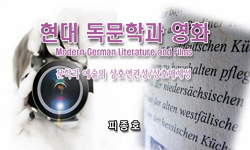This paper traces and identifies intermedial theatricality in Stoppard's early play After Magritte (1970), showing how this is used to illustrate themes such as the discrepancy between appearance and reality, or the notion that reality can be more mys...
http://chineseinput.net/에서 pinyin(병음)방식으로 중국어를 변환할 수 있습니다.
변환된 중국어를 복사하여 사용하시면 됩니다.
- 中文 을 입력하시려면 zhongwen을 입력하시고 space를누르시면됩니다.
- 北京 을 입력하시려면 beijing을 입력하시고 space를 누르시면 됩니다.
https://www.riss.kr/link?id=A100401426
- 저자
- 발행기관
- 학술지명
- 권호사항
-
발행연도
2014
-
작성언어
-
- 주제어
-
KDC
840
-
등재정보
KCI등재
-
자료형태
학술저널
- 발행기관 URL
-
수록면
219-237(19쪽)
- 제공처
-
0
상세조회 -
0
다운로드
부가정보
다국어 초록 (Multilingual Abstract)
This paper traces and identifies intermedial theatricality in Stoppard's early play After Magritte (1970), showing how this is used to illustrate themes such as the discrepancy between appearance and reality, or the notion that reality can be more mysterious than fiction, by ironically reworking and re-playing the conventions of precursor visual texts. As the pun in the play's title suggests, After Magritte challenges the way we see what we see and explores the way art defines reality. Using the illusion of Magrittean visual qualities on stage, via the crucial opening and closing tableaus, Stoppard comically situates the reader/audience in the in-between space of the absurd and the rational, and of the dark and the light, while raising questions about the logic of normality and the errors of interpretation. The farcical yet serious complexity of perceptions portrayed in After Magritte is characteristic of Stoppard's work, along with the verbal wit and logical congruity, marking this play as fully deserving its place in the appreciation of these displays of comic theatricality.
목차 (Table of Contents)
- Abstract
- 1. Introduction
- 2. Stoppard and Intermediality/Intertextuality
- 3. An Impressionist Stage: Appearance and Reality
- 4. Reality is Stranger Than Fiction: After Magritte
- Abstract
- 1. Introduction
- 2. Stoppard and Intermediality/Intertextuality
- 3. An Impressionist Stage: Appearance and Reality
- 4. Reality is Stranger Than Fiction: After Magritte
- 5. Conclusion
- Works Cited
동일학술지(권/호) 다른 논문
-
- 한국영미어문학회
- 최태숙(Tae Sook Choi)
- 2014
- KCI등재
-
- 한국영미어문학회
- 남정애(Jung ae Nam)
- 2014
- KCI등재
-
- 한국영미어문학회
- 안중은(Joong Eun Ahn
- 2014
- KCI등재
-
Revisiting Vocabulary Knowledge: A Focus on Colligation
- 한국영미어문학회
- Tae hyon Park
- 2014
- KCI등재






 스콜라
스콜라




